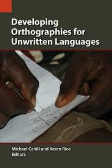[MLE] New book - Orthographies
Dear Multilingual education friends,
Some of the tribal groups in need for education in their mother tongue do not yet have a proper orthography. A new books has come out that topic:
· Michael Cahill & Keren Rice (Editors). 2014. Developing Orthographies for Unwritten Languages. SIL International. 276 pgs
Regards,
Karsten
Some of the tribal groups in need for education in their mother tongue do not yet have a proper orthography. A new books has come out that topic:
Developing Orthographies for Unwritten Languages
Linguistics and Orthography
·
Karsten
Karsten van Riezen
Education Consultant, LinkedIn Profile
Education Consultant, LinkedIn Profile
Disclaimer: This mailing list is an informal way to share mother tongue based multilingual education (MLE) related information. The sender neither claims credit or responsibility for the reports and events shared through this mailing list. Subscribing or unsubscribe by writing "[MLE] Subscribe" or "[MLE] Unsubscribe" in the subject-line and send a message to: karsten_van_riezen@sil.org. Any contributions or suggestions are welcome.
|
Table of Contents
Developing Orthographies for Unwritten Languages
1. Introduction – Keren Rice and Michael Cahill
1.1 Why this orthography book?
1.2 The papers
2. Non-Linguistic Factors in Orthographies – Michael Cahill
2.1 Introduction
2.2 Governmental policies and restrictions
2.3 Sociolinguistic factors: “All orthographies are political”
2.4 Educational and psycholinguistic factors
2.5 Practical production factors (fonts)
2.6 Further discussion
3. Orthography and Phonological Depth – Keith Snider
3.1 Introduction
3.2 Why native speakers are aware of the output of lexical processes
3.3 Orthographic representation of morphophonemic alternations
3.4 Conclusion
4. Orthography and Tone: A Tone-System Typology with Implications for Orthography Development – Constance Kutsch Lojenga
4.1 Introduction
4.2 Tone languages
4.3 Tone orthography
4.4 A typology of African tone systems
4.5 Consequences for tone orthography and teaching methodology
4.6 Conclusion
5. Basic Principles for Establishing Word Boundaries – Constance Kutsch Lojenga
5.1 Introduction
5.2 Word boundaries
5.3 Criteria for writing grammatical morphemes
5.4 Morphosyntactic topics
5.5 Steps in establishing word boundaries: a summary
6. Standardization: What’s the Hurry? – Elke Karan
6.1 Introduction
6.2 The “normative” expectation
6.3 Conditions which justify slowing down or delaying standardization
6.4 Standardization and the implementation of a reform take time
6.5 Additional case studies
6.6 Conclusion
7. Orthography Wars – Leanne Hinton
7.1 Orthography and politics
7.2 Five criteria for an adequate new writing system
7.3 The bias of familiarity
7.4 Case studies
7.5 Some compromises to consider
7.6 Conclusion
8. Breaking Rules for Orthography Development – Pamela Munro
8.1 Introduction
8.2 Orthographies and orthographic rules
8.3 Case study 1: Tlacolula Valley Zapotec
8.4 Case study 2: Gabrielino/Tongva/Fernandeño
8.5 Conclusions
9. A Yanesha’ Alphabet for the Electronic Age – Mary Ruth Wise
9.1 Introduction
9.2 Summary of Yanesha’ phonology
9.3 History of Yanesha’ alphabets and literacy
9.4 The change process and the official alphabet
10. Kurtöp Orthography Development in Bhutan – Gwendolyn Hyslop
10.1 Introduction
10.2 Linguistic factors
10.3 Non-linguistic factors
10.4 Application to Kurtöp
10.5 Summary and conclusions
11. Case Studies of Orthography Decision Making in Mainland Southeast Asia – Larin Adams
11.1 Linguists as activists
11.2 Case Study I: E and H
11.3 Case Study II: Lisu and Lahu
11.4 Case Study III: LR
11.5 Concluding notes
--
Document
